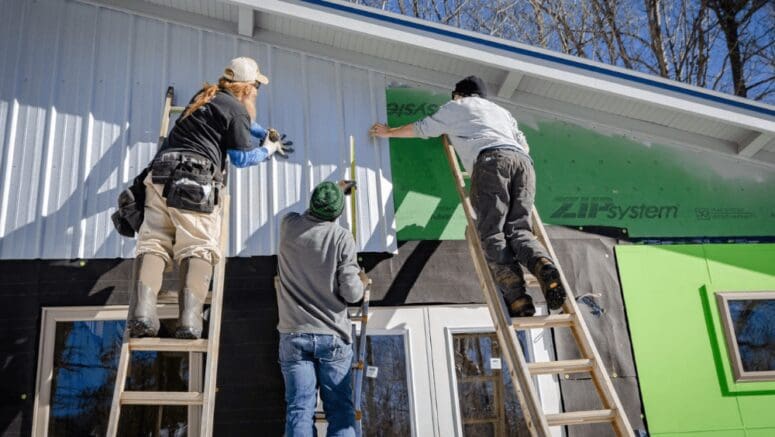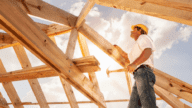

Evette is just your average HGTV fan who dreams of having a home worthy of being on one of those shows. When she isn't writing for HomeLight, she's working at her local real estate office. In her downtime, you'll find her searching for the next great hiking trail in her area.
Taryn Tacher , Senior Editor Taryn Tacher Senior EditorTaryn Tacher is the senior editorial operations manager and senior editor for HomeLight's Resource Centers. With eight years of editorial and operations experience, she previously managed editorial operations at Contently and content partnerships at Conde Nast. Taryn holds a bachelor's from the University of Florida College of Journalism, and she's written for GQ, Teen Vogue, Glamour, Allure, and Variety.
This is it — you’re finally making the move to build your very own house, and you couldn’t be more excited! It’s a huge decision, and it’s not one you’ve taken lightly. But do you know what goes into a new construction home, start to finish?
If not, don’t worry — we’ve got you covered. We’re going to break down all of the steps of building a house.
We have a lot of ground to cover, so grab a snack!
First thing: Talk to an expert!
A top local real estate agent will have connections to builders in the area and can offer a wealth of advice on how to navigate the whole process. Get the ball rolling by connecting to a highly rated agent through HomeLight today. It’s free, and it only takes a few minutes.
The very first step to building a house is buying the ideal plot of land for your new dwelling.
Think about where you’d like to build. Do you want to live in the country with a large yard? Do you want to build a house in a growing development with a developer? Does the land already have access to utilities like water, sewer, and electricity?
Unfortunately, you can’t buy any old vacant lot — it must adhere to zoning ordinances where you want to build. Common zoning designations include:
There are three types of builds available: spec homes, tract homes, or a fully custom home.
Spec homes are single-family homes that are built in a development with no particular buyer in mind.
If you go under contract early enough on a spec home, you may be able to choose some features like flooring, paint, kitchen appliances, and other finishes.
Tract homes are when a developer buys a large plot of land and divides that land into individual lots. They’ll then construct homes from specific architectural options planned for that community.
Tract homes could include single-family homes, condos, or townhomes.
A custom home is where you have your own plot of land and hire a builder to build a house exactly the way you want it.
Top real estate agents often advise clients that it’s easier to build a custom home because you have more choices. You can build the house from the bottom up and in the way you want — you’ll have to pay accordingly. With a spec home, your options are limited. Contractors may only offer shades of white or certain cabinets. They’re basically cookie-cutter homes.
Regardless of which type of home you want, you’ll want to look at the different floor plans available. Consider things like:
Building a home is a huge project, and the average build will involve 22 subcontractors working on the home.
The first person you’ll need to hire is the general contractor or a custom home builder. They will oversee the construction of your home from start to finish. Their duties include:
Note: Custom home builders and general contractors are not the same thing, but they are very similar. A custom home builder draws up blueprints for the home and specializes in custom homes, whereas a general contractor does not.
Before construction can begin, your contractor will contact your municipal office and discuss your plans. They’ll know what permits are necessary, and they might already have a relationship with the municipality, which could help speed up the process.
If you’re on a budget, you could get the permits yourself, but then you’ll be considered the contractor, and you would be liable if there’s a problem during construction or inspections.
Warning: Do not, under any circumstances, begin construction before obtaining permits! If the city learns that you do not have a permit, you could face increased fees to obtain the proper permits, and you could have to shut down construction until the permits are obtained or even tear down work you’ve already completed.
During this step, a professional land-clearing team will remove any debris, vegetation, trees, brush, and rocks within the intended build site.
When trees, shrubs, and bushes are removed, the team will also begin removing stump and root systems to prevent re-growth.
Note: If there are a lot of trees that need to be removed, you may have the option of selling the trees to a commercial logging company so they can be repurposed and turned into lumber.
Once the land is cleared, the clearing team will fill in any holes and level the ground. Then, the team will put up wooden stakes to mark where the foundation should be poured.
If the land has dips or hills, these will be graded to make sure there’s a flat surface to accommodate the house and driveway.
Using the wooden stakes as a guide, the team will dig holes and trenches for the foundation, utilities, and septic system if applicable.


Footings can be made from concrete or brick masonry and are most commonly used with shallow foundations because they distribute the weight of vertical loads directly to the soil. Footings are generally wider than the foundation and sit one foot below the frost line (the typical depth at which the soil freezes in your climate).
Footing drains will be constructed so that water drains away from the house and protects the drains from damage.
With the footings in place, your home will have either a slab foundation, a crawlspace, or a full basement poured or constructed.
The concrete will go through a curing process to reach maximum strength. This can take anywhere from 28 to 60 days, but depending on weather conditions, the building can resume after one week.
Regardless of the type of foundation your home will have, it will have to be waterproofed.
Once the foundation has cured, drains, sewer lines, water taps, and other plumbing that is needed on the first floor will be installed. Then, the contractors will fill in the trenches surrounding the foundation with excavated dirt.
After the footings, foundation, plumbing, and electrical basics have been laid, there will be an inspection to make sure the foundation was done correctly and follows local code requirements.
Some things the inspector will look at typically include:
Once the inspector gives the project the green light, next comes the framing.
This is where you’ll finally see your home take shape. The framing crew will erect lumber for the walls, flooring, ceiling, and roof trusses. This step could take between one and two weeks to complete.
The sheathing is the large sheets of wood, oriented strand board, wafer board, or exterior gypsum that’s nailed to the frame. Though the minimum is 7/16” in thickness, it’s recommended to use half-inch panels for structural sheathing to give the structure more strength.
In some cases, insulation sheathing (rigid foam or cellulose-fiber panels) may be used to improve insulation. This type can be attached directly to the studs, below the wood sheathing. It could also be attached on top of the wood sheathing.
Next, the sheathing is covered with house wrap, a protective cover that prevents moisture from seeping into the underlying wood, preventing mold and wood rot.
With the sheathing attached to the bones of the house, the windows and doors can be installed.
When you’re shopping for windows and doors, look for energy-efficient windows with the Energy Star label. Energy-efficient windows and doors will help lower energy costs by keeping the temperature indoors consistent, no matter the temperature outdoors.


The HVAC technician will come in to install ductwork throughout the house. The air handler, condenser, and trim work will be installed as well.
A plumber will come in and run pipes to the bathrooms, kitchen, and laundry room. They will also install sewer lines, vents, and bathtubs.
This step can be done while the doors and windows are being installed.
Although a licensed plumber may have done the work, an inspector will have to come in and inspect the work to make sure everything is done correctly.
The inspector will look for leaks and will ensure that the drains, sewage, and vent pipes pass a pressure test.
This stage is when all of the electrical work is done.
The wires are run through the walls and ceilings. The HVAC is hooked up (including the thermostat), and the fans, lights, electrical outlets, external electrical work, and the circuit breaker are also hooked up and ready to go.
Once the HVAC and electrical work are complete, an inspector will come out and make sure these systems work properly and are completed to code.
The sheathing for the roof is generally done when the exterior sheathing is attached to the walls.
During this stage, the roof will be completed. Roofers will install the flashings and asphalt shingles — but other materials may be used, such as clay or concrete tile, slate, metal, or wood.
The type of insulation your home will need is going to depend on your location.
Usually, insulation is applied to interior walls, the attic, basement, crawl space, and exterior walls (if it wasn’t applied before the sheathing).
The most common types of insulation are fiberglass, cellulose, or foam spray insulation.
Fiberglass insulation is used in unfinished walls, floors and ceilings. It comes in rolls and is installed in-between studs, joists, and beams. The average cost for fiberglass insulation is between $0.30 to $1.50 per square foot.
Cellulose insulation is used in existing and enclosed walls or new open cavities in the wall. This insulation can be used in unfinished attic floors and other hard-to-reach places. This type of insulation can be poured, but is usually blown into place using special equipment. The average cost of cellulose insulation is about $0.60–$2.30 per square foot.
Foam spray insulation is much like cellulose insulation, as it can be applied in enclosed, existing walls, new wall cavities, and unfinished attic floors. It is applied using a spray container (for smaller areas) or a pressure spray product (for larger areas). The average cost of foam spray insulation is between $1 to $2 per square foot.
Drywall is hung throughout the interior of the house, as well as on the ceiling.
After the drywall is hung, a texture may be sprayed on the drywall. Then, the walls are primed so they can be painted.

 was built cheaply." width="192" height="108" />
was built cheaply." width="192" height="108" />
We’re nearing the final steps to building a house!
At this stage, the walls will be painted, and it’ll start feeling a little more like your home.
If you’re going with a spec or tract home, you may not have many choices in paint color, but if it’s a custom home, you could have your choice of colors or even have wallpaper put on the walls.
There are different types of siding that can be applied to your home.
Vinyl siding is the cheapest siding material ($3 to $12 per square foot) and the most common material used for spec and tract homes. However, if you’re going custom, other options include:
Once the paint has dried, flooring is laid throughout the house.
Sometimes you won’t have a choice what type of flooring you’ll get if you’re going with a spec or tract home; however, with a custom home, the sky’s the limit!
When the flooring has been laid, next comes the trim.
Trim will be installed around the windows and doors, along the floor, and, if you choose, around the ceiling, too (that’s called crown molding and can add a sophisticated look to any room).
Vanities and cabinets are the next things to be installed in your home.
Spec and tract homes typically come with builder-grade cabinetry, which is the most basic (and affordable) type of cabinetry you can get that still looks good.
You can opt for higher-quality cabinets and vanities, but that will affect your budget. Custom cabinets can cost between $500 to $1,200 per linear foot!
After the electrical work is finished, light fixtures, outlets, and switches are hooked up.
These features can be customized to match your personal style, but you can also opt for plain white ones and upgrade down the road if you choose.
Countertops and appliances are the next things to go in. There are a variety of countertops you can choose from, but the most popular include:
Bathroom fixtures such as faucets, showerheads, toilets, heat register covers, and other features are added during this phase.
Along with bathroom fixtures, mirrors are hung in the bathroom and other spaces, including walk-in closets, bedrooms, and workout rooms (if in a custom home).
You put so much care into what goes in the house; you can’t forget about the exterior!
A professional landscaper can come in and lay down sod, plant trees, or flowers. They’ll install walkways, build decks or patios, create garden walls, and so much more.
This is your chance to make your yard an oasis that leaves your neighbors green with envy!


The final home inspection is where a home inspector looks over everything.
They’ll double-check the plumbing, electrical, and HVAC systems. They’ll inspect doors, windows, the foundation, the roof, and more. If the structure passes the inspection, they’ll give you a certificate of occupancy, which means it’s inhabitable and safe to live in.
If there are any issues, another inspection may be required after those problems have been fixed.
The final walkthrough is your opportunity to go through the house and make sure everything is as you requested.
You’ll want to pay close attention to the details and take note of anything that isn’t what you discussed or approved with your contractor. You’ll also want to look for any signs of damage that may have occurred during the final stages of construction, such as gouges in countertops, dented or scratched appliances, deep scratches on the hardwood floors, or damaged walls.
If everything passes inspection and you don’t find any problems that need to be addressed during the final walkthrough, you can begin the closing process on the home. Hurray!
Find a top real estate agent near you
We analyze over 27 million transactions and thousands of reviews to determine which agent is best for you based on your needs. It takes just two minutes to match you with the best real estate agents, who will contact you and guide you through the process.
The average homebuyer looks at at least 7 homes in 10 weeks before submitting an offer on a house. There are times when they can’t find a house they want to buy, and they’ll go with a new build. In July 2024, 1,396,000 permits for new construction homes were issued across the United States.
If you decide that new construction is right for you, but you’re uncertain about what type of new build you’d like to go with, look at your budget and try to decide the level of customization you want and how much house your budget will allow for.
For top real estate agents, there is value in going with a tract home. You can go to a tract home and get a lot more square footage for the money than you could with a custom build. It’s a cookie-cutter home, and the quality may not be as good as a custom build, but building custom is harder today because the price of materials has skyrocketed.
If customization isn’t high on your list, a tract home or spec home is a great option. However, if you want a house that reflects your personality from the moment you sign the closing papers, then a custom home is the way to go!
Header Image Source: (Jens Behrmann / Unsplash)
At HomeLight, our vision is a world where every real estate transaction is simple, certain, and satisfying. Therefore, we promote strict editorial integrity in each of our posts.
Evette is just your average HGTV fan who dreams of having a home worthy of being on one of those shows. When she isn't writing for HomeLight, she's working at her local real estate office. In her downtime, you'll find her searching for the next great hiking trail in her area.
Taryn Tacher is the senior editorial operations manager and senior editor for HomeLight's Resource Centers. With eight years of editorial and operations experience, she previously managed editorial operations at Contently and content partnerships at Conde Nast. Taryn holds a bachelor's from the University of Florida College of Journalism, and she's written for GQ, Teen Vogue, Glamour, Allure, and Variety.
Share this post